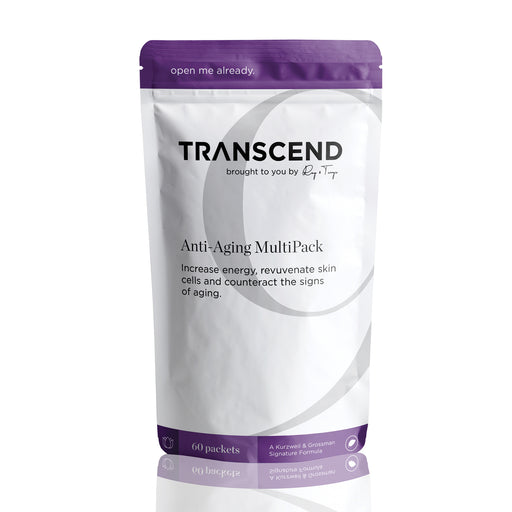
Vitamin B-12, Sublingual
Increased energy Improve mood Fight fatigue Common deficiency Better absorption Vitamin B12 (also called cobalamin) is one of eight water-solu...
View full details
HOW FRESH IS FRESH?
Turkey, stuffing, cranberry sauce, and pie will soon fill our kitchens with the sweet smell of Thanksgiving. If you’re anything like us, you’ll need to clear out a few things from your fridge before you can squeeze in all of the leftovers. As you stare into your salad crisper and decide what to keep and what to toss, take a moment to read the labels. Where do your vegetables come from? Here is what we found in our TRANSCEND fridge: cucumbers from Ontario Canada, green beans from Florida, grapes from California, lemons from Argentina, and oranges from South Africa. Imagine the trucks, boats, and people involved in getting all of that produce to our table!
Now, consider the quality of your produce. Are your tomatoes sweet and firm? Broccoli crunchy? Strawberries fresh and juicy? What does “fresh” actually mean? Our agricultural system depends on the weather which means we are constantly chasing the perfect environment to grow the perfect crops. And sometimes that perfect environment is thousands of miles from where we live, which means those crops have to spend weeks or months in cold storage and on trucks before they arrive in our local markets. Did you know that the typical storage time for apples is six to twelve months before they are put out for sale? Lettuce is stored for up to four weeks, tomatoes are stored for up to six week, and carrots are stored for up to nine months. Yet they are all considered “fresh” by current standards.
Even with our vast shipping system, according to the U.S. Department of Agriculture, twenty million people in the United States have limited access to affordable, healthy foods regardless of the time of year. Known as “food deserts,” they are typically found in urban population centers, especially low income neighborhoods, where supermarkets are few and far between and public transportation is spotty.
But, there is a new way of farming that has the potential to change everything. Historically, growing plants in the earth, under the sun has been a simple fact of life. Humans have been cultivating crops horizontally for eleven thousand years. However, in 1909 Americans got their first glimpse of a “modern” vertical farm in a drawing that appeared in LIFE Magazine. Then, in 1929 the concept of hydroponics was introduced -- the process of growing plants with sand, gravel, or liquid, with added nutrients, but without soil. And in 1999 Dickson Despommier, a professor of environmental health sciences at Columbia University, challenged his graduate students to design a rooftop farm that could feed 50,000 New Yorkers. This marked the beginning of modern vertical farming as we know it today.
WHAT IS VERTICAL FARMING?
In vertical farms, plants are grown indoors, in trays of nutrient-rich water that are loaded into frames and stacked many stories high. Instead of sunlight, special LEDs are installed to ensure that each plant gets the perfect amount of light. The water, air temperature, amount and type of light, and nutrients are all carefully controlled by artificial intelligence to optimize growth.
If you’ve driven through Newark on the New Jersey Parkway in the past six years you’ve probably passed one of the world’s largest indoor vertical farms without even knowing it. Founded in 2004 in Ithaca, NY, AeroFarms moved into a former paintball and laser tag arena in Newark in 2015 and has since expanded into a nearby defunct steel mill. If you live in the Bay Area you may have heard of Plenty, a vertical farming company that raised $200 million dollars in 2017, representing the largest agricultural technology investment of all time. Plenty is now launching a 95,000 square foot indoor farm in Compton, CA.
Similar farms are being built around the world. Japan has over two hundred vertical farms with the largest facility producing 30,000 heads of lettuce per day. Yes, folks, you read that right. Thirty thousand heads of lettuce a day.
ONE (OF MANY) REASONS TO CARE:
The health benefits of eating fruits and vegetables is not breaking news. Ray and Terry’s food pyramid is built on a foundation of five to seven servings of vegetables a day. In TRANSCEND: Nine Steps To Living Well Forever, they recommend eating organic whole foods grown without the use of chemical fertilizers, pesticides, and herbicides whenever possible. They urge readers to eat locally-grown fresh produce whenever possible because it retains most of its vitamins, minerals, enzymes, phytochemicals, and other nutrients. These recommendations are part of their practical program to living as happy and healthy as possible, for as long as possible, in order to benefit from the fast approaching merger of artificial intelligence and medicine. If you live in a city (82% of us do, according to the United Nations), vertical farms could be your ticket to year round, locally grown, pesticide free, fresh produce.

BENEFITS OF VERTICAL FARMING:
-Weather is obsolete. In vertical farms, crops can be grown anywhere anytime. They are never lost to storms, draught, or temperature dips.
-Less land produces more food. Currently, half of the world’s habitable land is used for traditional agriculture. Meanwhile, 700 acres of horizontal farmland can fit in one vertical farm the size of a big box retail store. For every indoor acre of farm created, ten to twenty acres of outdoor land can be returned to native plants and animals.
-No bugs means fewer pesticides. Indoor farming is clean and pest free. Without bugs and weeds there is no need to use toxic pesticides and herbicides.
-Impressive water conservation. Horizontal agriculture uses 70% of all available fresh water in the world. In contrast, vertical farming recycles as much as 95% of the water it uses and eliminates run off (one of the biggest sources of pollution on the planet) through a closed loop system.
-An abundance of high quality produce. Vertical farming produces up to ten times the crop yield of traditional farming due to artificially intelligent systems that constantly tweak the lighting, temperature, moisture, and nutrients to optimize growing conditions.
-Less shipping means less toxic emissions. Vertical farms are popping up in former factories, disused warehouses, and shipping containers located in urban areas while traditional farms are typically hundreds to thousands of miles away from our homes. By growing produce close to where we live, shipping and related carbon emissions can be dramatically reduced.
-The potential to eradicate “food deserts.” When farming expands from remote rural areas into cities, access to fresh produce increases in neighborhoods that were once cut off from the produce supply chain. Consider the impact that Plenty’s new 95,000 square foot vertical farm will have on its hometown of Compton, CA.
CRITICISMS OF VERTICAL FARMING:
-Replacing the sun with artificial lighting requires an enormous amount of energy. Every stacked layer of plants requires its own layer of lighting. Indoor farms also require constant ventilation and cooling. When non-renewable energy is used for power, vertical farms create larger carbon footprints than traditional farms.
-It is extremely expensive: Setting up a vertical farm is much costlier than a traditional farm. AeroFarms paid an estimated $39 million dollars to expand their farm into a 69,000 square foot steel mill in Newark, NJ. Once in operation, it costs three to five times as much to grow produce in a vertical farm than a conventional farm.
-Limited variety of produce: Currently, vertical farms are primarily growing leafy greens and herbs because of their short growing cycle, small size, and high demand in the marketplace. And, they cost less to grow than other crops. (Although, it’s worth noting that some farms are starting to produce tomatoes, eggplants, peppers, cucumbers, strawberries, and other soft fruits).
OUR TAKE ON IT:
The primary criticisms of vertical farming ignore the fact that technology is advancing at an exponential rate. According to Ray’s Law of Accelerating Returns technology is generally doubling in price-performance, capacity, and bandwidth every year. This means that the 21st century will see 20,000 years of progress at today’s rate. The critics of vertical farming see a linear future, where the rate of progress tomorrow will be the same as today. Yet, data shows that technological progress has been advancing exponentially for more than one hundred years. That is a huge difference. If you count 30 steps linearly, 1,2,3,4… and so on, you get to 30. If you count 30 steps exponentially, 2,4,8,16… and so on, you get to a billion. Those are extremely different end points.
In his forthcoming book, The Singularity Is Nearer (Viking, 2022), Ray writes,
|
“In the coming years, converging innovations in photovoltaic electricity, materials science, robotics, and artificial intelligence will make vertical farming much less expensive than current agriculture. Many facilities will be powered by efficient solar cells, produce new fertilizers on-site, collect their water from the air, and harvest the crops with automated machines. With very few workers required and a small land footprint, future vertical farms will be able to produce crops so cheaply that consumers may be able to get food products almost for free.” “This mirrors what has happened in information technology due to the Law of Accelerating Returns. As computing power has gotten exponentially cheaper, companies like Google and Facebook have been able to provide their services for free to users, while paying for their own costs through alternative business models such as advertising. By using automation and AI to control all aspects of a vertical farm, vertical agriculture represents turning food production essentially into an information technology.” “The costs of environmentally friendly renewable energy have been dropping exponentially and the cost of vertical farming will also come down due to the powerful deflationary force of information technologies, both hardware and software, which is about 50 percent per year.” |
RETHINKING OUR THINKING:
A paradigm shift like vertical farming is easy to dismiss when it first takes shape because of its unconventional ideas and methods that challenge our assumptions. It often involves new technologies that are clunky and expensive. Take early cell phones as an example. In 1973 Motorola introduced a cell phone prototype that cost $4,000 dollars (that’s $24,000 in today’s dollars), weighed two and a half pounds, offered 30 minutes of talk time, and required 10 hours to recharge. And all it did was place and receive phone calls. Today, 85% of Americans own smart phones that can access all of human knowledge with a few keystrokes at a fraction of the cost. This is the nature of technology – it advances exponentially. Vertical farming is no different. If you ask an exponential thinker, it won’t be long until Thanksgiving dinner is packed with fruits and vegetables from nearby vertical farms. And we’ll give thanks for the abundance of truly fresh food, harvested around the corner, as we remember the old days when produce was stored for months and shipped for miles before it made it onto our tables.

Increased energy Improve mood Fight fatigue Common deficiency Better absorption Vitamin B12 (also called cobalamin) is one of eight water-solu...
View full details
Combat internal aging Protect cells from radiation damage Increase antioxidant capacity Take with lecithin for better absorption Optimal dose for...
View full details
2022 update: Future batches of this product will use a Ubiquinol product that is a greenish capsule rather than a red softgel Bioavailable form o...
View full details
2022 update: to maintain the same dose of Phosphatidylcholine you are accustomed to, we are moving back to the 420mg in 2 softgels! 2022 update: ...
View full details
Comments
Leave a comment